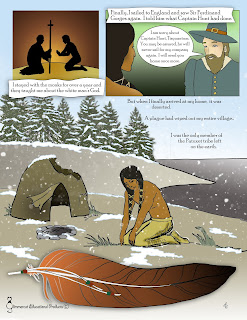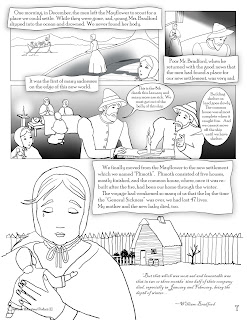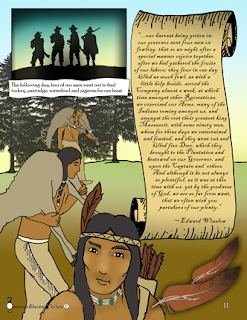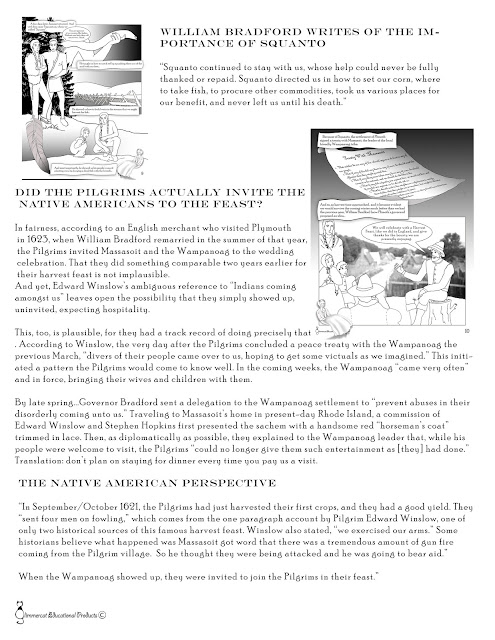Graphic Novel based on the first Thanksgiving. It was a labor of love and a stretch of my creativity and I am not ashamed to admit it! It also took a great deal longer to research than I had originally planned, but included in the novel are many primary sources from the era.
When it comes to beloved holidays, there is always a desire to keep the traditional beliefs we grew up with as children. Sometimes it hurts to peel back the covers and discover that not all those traditions were based on fact. But, if we are brave enough to do so, there are often these serendipitous discoveries we find that are even more to be treasured than the beliefs we formerly held.
But if there is one idea that trumps all traditions, it is: Veritas! Truth!
This value of truth was what grounded me through the
creation of this product. That and a love for history that is rooted in the optimistic.
The Graphic Novel begins with Tisquantum (whom we know more generally as Squanto). Most of us have heard that Squanto was captured and enslaved by the English before his assistance of the Pilgrims. But researching more about Weymouth and how he executed that capture was fascinating.
Some historians debate whether Squanto was included in this first capture of five young Native Americans. But Sir Ferdinando Gorges and a shipmate of Weymouth seem to imply by their writings that Tisquantum was included.
Weymouth used several articles to entice the young braves onto his ship. One of these was the English pea. I chose to show it as the vegetable, but the writings suggest that the peas were canned. Who knew they could can peas all the way back in the 1600's? (Okay maybe some of you knew that. I did not).
For years, Tisquantum lived with Gorges in England, and of course, learned his excellent English. He is finally released for his return to his country...
...When Captain Thomas Hunt happens.
Now I knew a rough idea of the story of Squanto's capture, but I did not know that Hunt knew Squanto quite well: At least, Hunt was the captain of the ship that sailed with Tisquantum's Captain, John Smith.
I only show Squanto in chains on this page. Hunt actually captured over 20 Native Americans, many of which were of the Nausett and Naragansett Tribes, which then decided to have nothing to do with white men (understandably) from there on out.
These tribes were rather antagonistic to the new settlers (whom we call Pilgrims), and knowing their backstory, we can definitely understand their feelings.
Because Tisquantum is rescued by the Spanish monks (once he reaches the Spanish coast), he is taught by them in the Christian religion.
Some leave this out of Squanto's story, but I chose to leave it in, for even on his deathbed (a few years after meeting the Pilgrims), he asked William Bradford to pray for him "to the white man's God", and so this time with the monks was significant to Squanto and I felt it was important to include.
I leave Squanto's story here in the Graphic novel, and move on to Remember Allerton, a little Pilgrim girl onboard the Mayflower.
I do not refer to these new settlers as Pilgrims, since they themselves only refer to themselves by that name once in their writings (that I could find) and seemed to think of themselves in that light, more in a poetic sense, as those with such a religious culture might. They were new settlers, or of course, Separatists. But, in the eyes of a little girl, such titles are not necessary. Remember simply tells her story.
When I think of the Mayflower, I think of visiting the tiny replica of the ship in Massachusetts back in 1998, as I had the opportunity to do.
I remember being incredibly shocked at the small space and having an inability to fathom so many people being stuck inside of it for such a long time.
I do not think my pictures adequately convey how small the Mayflower is, so I mention it here.
What a relief it truly must have been to finally see land! And yet, finding the land must have been disappointing, too. This brings me to Mrs. Bradford.
Historians debate what really happened to poor Mrs. Bradford on that fateful day that her husband sailed away to scout out the land. Suicide for one of the religious Separatists would be something terrible to consider. But when we understand how dreadful depression can be, we can understand that tragedies like these can come against the best of us.
I do not state that Mrs. Bradford committed suicide in the graphic novel, for we don't know this for sure. She simply falls overboard and they never heard cries for assistance. But through the eyes of a child, the continued deaths of the adults onboard are still devastating. I try to portray Remember's story as gently as I can, while still covering the pain of what she saw: her mother, a sibling, and more than half of the adults on the voyage die.
When Samoset arrives in the settlement, it is a turning point for all. A turning point for the best.
I found references that said that Samoset entered dressed only in a loincloth, which had to be staggering to the Europeans, who were still struggling with the harsh New England springtime. After all, I visited in New England myself in March, and I wore sweaters and long pants!
There is a legend (I couldn't find a historical reference), that Samoset entered the new settlement with two arrows, pointing forward and backwards. The legend suggests that he was asking the pilgrims a question with this symbolism: namely, are you enemies or are you friends?
I included this in the image, but I do not refer specifically to it in the story.
And so with Samoset comes Squanto, and with him the change in the fortunes of the Settlers.
He taught them more than I show here, but these would be the mainstays that would mean the Pilgrims could now survive and even thrive in this new world.
And the symbols used throughout the graphic novel (the feather for Tisquantum's story and the doll for Remember's) are now shown together for the first time.
The actual primary sources that we have for the original Thanksgiving feast are included within the novel itself. We have two that we are aware of: Edward Winslow's letter to a friend and William Bradford's general covering of the Harvest season, many years later.
On this page, we include Edward Winslow's letter excerpt which remains the most detailed we have of that first Thanksgiving.
There is actually more to Squanto's story that I do not share here as it does not pertain to the Thanksgiving Feast, but it is important to note. Squanto is a figure of controversy as he later began to look out for his own interests in his dealings with his own people in the negotiations he held between them and the Pilgrims. There is some debate whether he may have been poisoned by Massasoit's people because he simply had become untrustworthy to the great Chief.
Bradford does not mention poison, but he does mention Squanto's failings, and it was only through the intervention of Bradford that Squanto was allowed his safety, although he died shortly after 1621.
Again, it does not pertain to the Thanksgiving feast, so this is not mentioned in our story.
What we do share, in the back are an additional four pages of historical notes.
I include the Native American perspective of the Feast because it is important to remember that two incredibly diverse cultures were involved in that first feast and one culture's perspective has traditionally not been seen as important to the story.
I wanted desperately to find in my research that Bradford had indeed invited the Indians to the feast. There really is no record of such happening. It's possible, of course. Several years later, Bradford invites Massasoit to a wedding that takes place in Plimoth.
But it is as equally likely that the settlers didn't even think to invite the Native Americans to their Harvest feast and Massasoit's tribe discovered the feast going on and invited themselves, so to speak.
This doesn't mean the first Thanksgiving wasn't still an incredibly wonderful event. Truth is, there were few times in that era of history where two such diverse people groups would ever sit down to eat together. This is a time period where kindness was rather dim. Just take a look at the standard methods of punishment in Elizabethan England for this time period.
For the era, I still look on the First Thanksgiving as an anomaly in history, probably only possible with these two groups: one, a religious sect that demanded kindness as part of its belief systems (even though admittedly they were hoping to practice proselytizing this new people group) and two, the tribe of Massasoit, who was a leader spoken of with awe and appreciation by both Native Americans and the leaders of Plimoth in various letters.
To Purchase this "First Thanksgiving Graphic Novel" or see it in more detail, you may go to our TeachersPayTeachers online store.




















































